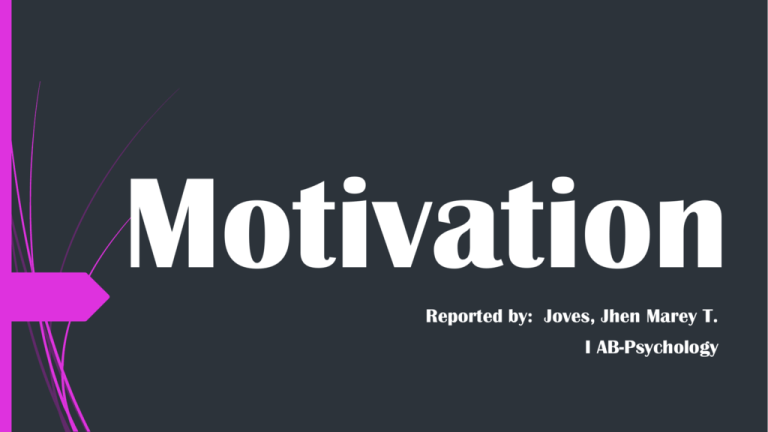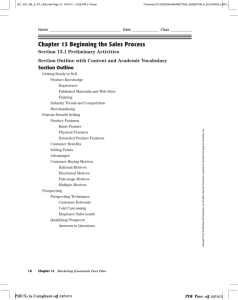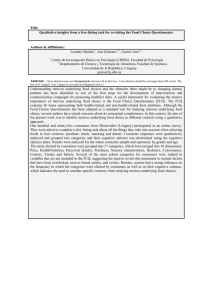Chapter 9. MOTIVATION
advertisement

Motivation Reported by: Joves, Jhen Marey T. I AB-Psychology Motivation is defined as the process that initiates, guides, and maintains goal-oriented behaviors. Every human behavior is caused by motivation. It is the driving force of human behavior. People think, feel, and act differently. Their behaviors are influenced by the kind of motivation they posses. Nature and Meaning of Motivation The term motivation is derived from the word motive. Motive in Latin means movere or motivum which means to move. We move differently in attaining goal. The same goal may be pursued for different reasons, or that different goals may be for pursued for the same reason. We use the concept motivation to explain all the aspects of behavior. Component of Motivation There are four components of motives: need, drive, response and goal. A need is a lack or deficit within a person. It is either Physiological (Biological), Psychosocial or Personal A drive activates a response. A response is a series of actions designed to reached a goal. A goal is a substance, object or situation that satisfies a needs. YES Needs (Food) Drive/ Urge (Hunger) Response ANNOYED FRUSTRATED Goals (Satisfaction) SATISFIED HAPPY CONTENTED Functions of Motives There are three functions of motives, namely; energizing, selecting, and sustaining function. The energizing function of motives makes the individual active. The energizing function of motives is caused by “push” and “pull”. Some persons are more energized by the “push” than the “pull” and vice versa. Individuals are selective in their motives. They select those motives that will facilitate the attainment of goals. Those motives that undesirable, repulsive, and unpleasant and make goal difficult to achieve are set aside. Not all motives have the same energizing power, that’s why the motive is selected because it can facilitate the attainment of goal. Some motive is stronger than others. Stronger motives are sustained while those which are not strong or are weak are rejected and sometimes attacked. The Cycle of Motivation Motivation has no end. As long as the individual is living, he is always motivated. Motives starts with a need and ends with a goal. When a goal is achieved, the individual rarely to stops upon reaching the goal. More often than not, the accomplished goal is repeated, like a cycle, or leads to other needs. Motivational Cycle, a never ending process of motivation. RESPONSE GOAL Motivation NEED DRIVE Origin of Motives Motives originated from two sources, namely; biological(physiological) and environmental. The human body needs these biological needs for nourishment and survival. This biological needs started in ancient time dating to the time of Adam and Eve– when they were in search for food and water in order to get nourishment and survive. Motives also come from environmental sources. Due to the presence of machines, equipment, gadgets and appliances, most of which are high-tech. Due to the increase of population, the psychosocial needs of men have also increased and become more stronger than before. Classification of Needs Needs are what individual lacks and wants to achieve for his survival and happiness. These things that our body needs to be able to survive are called physiological or biological needs. Those things that an individual needs to be able to relate happily with others are psychosocial needs. Both needs are responsible for our well-being. Physiological Needs Physiological needs are important for normal body functioning. They are considered as strongest of the two need categories. 1. Food-- Food provides the body with nutrients needed for production of energy, repair of damage tissues, growth of new tissues and regulation of physiological process. 2. Water– Next to oxygen(air) is water, the substance most necessary for survival. 3. Oxygen– Our body, especially the brain, lungs, tissues and other internal organs need oxygen for their functioning and activity. 4. Shelter– Our body must be protected and secured for temperature and other external stimuli. 5. Medicine– We need medicines to treat our illness, pain, injury, and to reduce discomfort. 6. Rest– Rest enables us to maintain homeostasis and it is a way of recharging our body and energizing it. 7. Elimination– Our body has to eliminate liquid and solid wastes to obtain relief. 8. Normal Temperature– Our body needs adequate and proper ventilation. Psychosocial Needs Man is not only a biological organism. It’s also a social being and as such. This needs interact and relate with people around. “No man is an Island” is capable to psychosocial needs. Love It is a very powerful need because it is a basic emotion in a man. Security and Safety An individual who feels secure and safe can work and function well at home and in the community. Security may be physical, social and emotional security. Acquisition This is the need to gain possession and property. Conservation This is the need to collect things, the need to repair destroyed equipment and materials and to clean and preserve those things acquired by the individual. Order This is need to arrange and organize objects in their proper order, the need to put away objects that are not needed anymore. Construction This is the need to build or put up something; it is also the need to organize a thing. Achievement This is a need to strive to do something difficult as well as quickly as possible; the need to overcome obstacles or to exercise power. Another Psychosocial needs; *Recognition *Autonomy *Affiliation *Nurturance *Play *Self-Esteem *Defendance *Aggression *Rejection *Succorance *Mastery *Intimacy Theories of Motives Theories are product of man’s thinking. They guide man to action. The theories of motives include: The Theory of Sequential Development This theory is also called Theory of Hierarchy of Needs. Abraham H. Maslow (1908-1970), a social anthropologist and founder of humanistic psychology, presented five levels of needs arranged in a hierarchy. The five levels of needs in their sequence starting from the bottom or lowest level are: Level 1, are the Physiological Needs, to keep the individual survive (food, air, water, sleep and clothing); Level 2, Safety and Security Needs (stability, security, and order); Level 3, Love ad Belongingness (affection, affiliation and identification); Level 4, Esteem and Prestige Needs (recognition, self respect, honor, achievement, competence and mastery, approval and self worth) and; Level 5, Self Actualization (self-fulfillment) , reaching one’s potential to the fullest, creativeness, and appreciation of beauty and symmetry. Psychoanalytic Theory of Needs Sigmund Freud, a Jewish Physician, is known as the Father of Psychoanalysis. Accdg. to him, human behavior is governed by the structured of his personality: ID, EGO, and SUPEREGO. The ID is the Animalistic nature of man – the “MAKAHAYOP” part of one’s personality. It is destructive and pleasure-seeking structure of personality. It is here where the sex urge(libido) is present. The EGO is the Human nature of man – the “MAKATAO”, the “Self”. It is the opposite nature of the ID. It builds; it acts accdg. to the laws and morals. It is bound by limits of reality. It channels the libido to socially approve outlets. The SUPEREGO is the Godcentered nature of man – the “MAKA-DIYOS”. It is the “conscience” part of our personality. It strives for perfection. *Instinct Theory Accdg. to William McDougall, human beings have a number of instincts, such as fight, repulsion, pugnacity, self-abasement, etc. Instinct are innate tendencies that predetermine behaviors, making an individual behave in particular way when confronted by a stimulus. It is a fixed action pattern. *Drive-Reduction Theory As a proposed by Clark Hull, human beings are engaged in a variety of behaviors , to reduce the drives that causes bodily tension. The need impels the drive (a state of tension or excitement). Once the need is satisfied, tension reduces and the body returns to it’s normal balanced state(called homeostasis). *Opponent Process Theory Acquired Motives Richard Solomon described two opposing process of motivation: the negative feeling is opposed to positive and positive feeling is reduced. Conversely, if the positive feeling is reduced, the negative feeling is increased. Another Theories; *The Theory of Needs. Henry Murray, an American Psychologist who constructed the Thematic Apperception Test (TAT). *Cognitive Theory of Motivation. Albert Bandura, Richard de Charm, Edward Deci and Bernard Weiner believed that cognitive concepts of Intrinsic motivation are the driving forces of human behavior. *Arousal(stimulation) Theory of Motivation. Accdg to this theory, a moderate level of stimulation that increases the level of tension and excitement reinforces behavior. *Superiority and Inferiority Theories. Accdg to Alfred Adler, THANK YOU FOR LISTENING!





